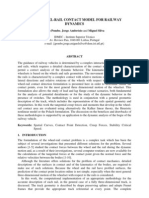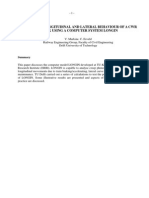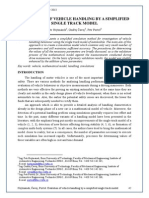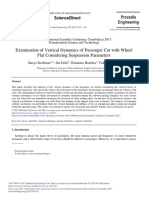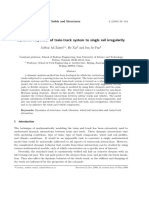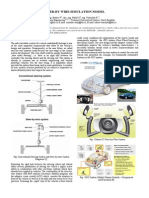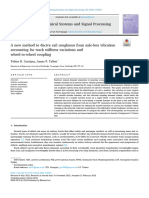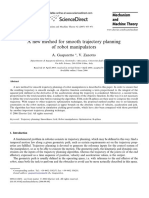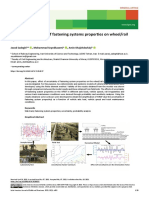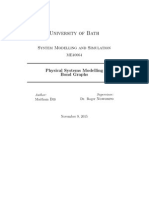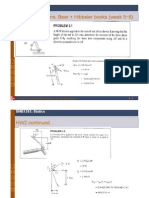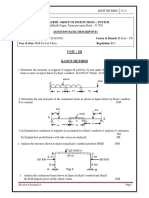Poster Presentation 3
Poster Presentation 3
Uploaded by
Julien FaureCopyright:
Available Formats
Poster Presentation 3
Poster Presentation 3
Uploaded by
Julien FaureCopyright
Available Formats
Share this document
Did you find this document useful?
Is this content inappropriate?
Copyright:
Available Formats
Poster Presentation 3
Poster Presentation 3
Uploaded by
Julien FaureCopyright:
Available Formats
Msc Advanced Mechanical Engineering 2010-2012 Faure Julien
Methodology:
Modelling the vehicle
Procedure of the complex model:
Mechanical aspect: finite element formulation rigid body dynamics
zc Direction of the passenger vehicle
Obtain a vertical profile of the track for a line grade
Mathematical Modelling of a train coach subjected to geometry faults
Context:
The importance of the dynamic is obviously related to the overall safety and performance for high speed. In railway history, the aim was to improve performance for braking and pulling the series of coaches. This aim was easily fulfilled compared to the dynamic aspect: the study of bogie stability, the understanding of the inner movements and has been a main stake which leads to the development of impressive high speed vehicles . The role of track on the behavior of trains is essential because the tracks represents the excitation force of the vehicle system and a poor quality of the track can trigger fatal accidents. This is the reason why, the overall track quality is assessed with 6 different grades and 4 parameters enables to judge the track:
Name Horizontal Alignement Gauge Vertical Versine Describing The rail has moved from its horizontal axis The distance between two rails has changed The track has a vertical defect which is symmetrical One of the two rails is above or under the other one Scheme
Statistics aspect : Irregularities uses PSD functions determined with experiments Acceleration variance follows normal distribution
Numerical Integration
zb2
b2
zb1
b1
zw1
zw2 zw3
zw4
Acceleration of the car body Variance of the acceleration of a 10s time period : Repetition of the mechanical procedure Estimate the distribution of for each line grade Estimate the reliability of the method
Hypothesis:
Vertical Dynamics of the coach considered One rail profile considered and half of the train modelled (symmetry) The track is straight, rigid and the vehicle is at a constant speed The rail/wheel contact is represented with a linear Hertz spring The car body and the bogies have two DOF (rolling & vertical motion) The irregularities are simulated with trigonometric functions (random phase angles) and a amplitude depending on PSD functions.
Simple model of the coach with 2 Degrees of freedom Modelling the track as a Bernouilli beam on discrete supports
Other work:
Horizontal Versine
Results:
Displacements of each component in function of the time:
Conclusion :
Line Grade
Problem statement:
The geometry quality of a railway track under loads can be indirectly measured analysing the dynamic response of a train coach travelling over it. Instruments to measure these reactions have been developed, but since the cost of the equipment of a normal train coach is considerably lower than that required for a track recording machine, usually this indirect methodology is adopted. These measurements can be at best an approximation of the railway track geometry, since the coach dynamic characteristics influence the response.
Objectives:
Experimental recordings with accelerometers in two car bodies (tramway & train) : The present work aims at : Obtaining the dynamic modelling (vertical and horizontal) of a typical train coach subjected to different railway track geometric faults (gauge, super elevation, twist) Correlating the accelerations inside the car body with the quality of the track and being able to find a trend. Having a reliability study on the results obtained and compare the results with the existing standards. the qualities of the two tracks are to60 tally different. 50 The vertical acceleration inside the 40 car body are also very different. 30 20 > Correlation between track irregulari10 ties and acceleration exist. 0 The order of magnitude of the maximum acceleration for simulation & Acceleration [mg] experiments are similar. > Simulations are validated and a reliability study can be done
Percentage [%]
Likelihood of the line grade as a function of the acceleration inside the car body (v=18.5 m/s) of one specific vehicle. The method enables us to obtain tables of likelihood depending on the line grade, the speed of the vehicle and the mechanical parameters of the track. > The accelerometers enables us to have a cheap way to measure the quality of tracks and fill the initial aim of the thesis.
Future Work :
Comparison of the maximal acceleration (real recording)
Line grade 6 Line grade 1
Refine the methodology be-3.5 0 0 0 0 3 97 cause it was the first attempt to -3.6 0 0 0 0 2 98 correlate track and acceleration. Define the best speed for track measurement (avoiding natural frequencies and have the largest confidence interval) Model the vehicle considering two deformable rails and make it more complex with lateral and longitudinal motions. Obtain experimental data for the line grades : The Gaussian process (random angles) to obtain the irregularity is questionable.
-1.3 -1.4 -1.5 -1.6 -1.7 -1.8 -1.9 -2 -2.1 -2.2 -2.3 -2.4 -2.5 -2.6 -2.7 -2.8 -2.9 -3 -3.1 -3.2 -3.3 -3.4
1 94 89 81 68 51 32 17 7 2 1 0 0 0 0 0 0 0 0 0 0 0 0
2 6 10 18 29 41 49 49 39 24 11 4 1 0 0 0 0 0 0 0 0 0 0
3 0 1 1 3 8 17 29 41 48 44 32 19 9 3 1 0 0 0 0 0 0 0
4 0 0 0 0 1 2 5 12 23 35 44 46 38 26 15 8 4 2 1 0 0 0
5 0 0 0 0 0 0 0 1 3 9 18 30 41 46 45 38 29 21 14 10 7 5
6 0 0 0 0 0 0 0 0 0 0 2 5 12 24 39 54 68 78 85 90 93 95
0 25
50
75 10 0 12 5 15 0 17 5
20
22
25
27
30
32
35
37
40
42
References :
Lei, X. (2002). Analysis of dynamic response of vehicle and track coupling system with random irregularity of track vertical profile. Journal of Sound and Vibration Sun, Y. (2002). A dynamic model for the vertical interaction of the rail track and wagon system. International Journal of Solids and Structures Dong, R. (1994). Vertical dynamics of railway vehicle track system. Romero, A., & Dom, J. (2010). Fully three-dimensional analysis of high-speed train track soil-structure dynamic interaction. Journal of Sound and Vibration Wu, J. (2000). The use of finite element techniques for calculating the dynamic response of structures to moving loads. Computers & Structures
Acknowledgments :
Dr Maurizio Collu Supervisor Cranfield University Mr Alban LeymarieLeyfa Measurement Mr Jean Michel Thiry Pr Jean-Pierre Fortin SNCF Dr Athanasios Kolios Cranfield University
45
You might also like
- 200 Puzzling Physics Problems Gnadig KF RileyNo ratings yet200 Puzzling Physics Problems Gnadig KF Riley271 pages
- Exponential Operators and Parameter Differentiation in Quantum PhysicsNo ratings yetExponential Operators and Parameter Differentiation in Quantum Physics22 pages
- A New Wheel-Rail Contact Model For RailwayNo ratings yetA New Wheel-Rail Contact Model For Railway26 pages
- Black-Box Modelling of Nonlinear Railway Vehicle Dynamics For Track Geometry Assessment Using Neural NetworksNo ratings yetBlack-Box Modelling of Nonlinear Railway Vehicle Dynamics For Track Geometry Assessment Using Neural Networks31 pages
- Computers and Structures: Nan Zhang, He XiaNo ratings yetComputers and Structures: Nan Zhang, He Xia9 pages
- (2006) ECCM2006 - JPombo - JAmbrosio PDFNo ratings yet(2006) ECCM2006 - JPombo - JAmbrosio PDF25 pages
- Locomotive Wheel Speed Measurement Under Wheel Slip ConditionsNo ratings yetLocomotive Wheel Speed Measurement Under Wheel Slip Conditions6 pages
- Application of a wheel-rail contact model to railway dynamics in small radious curved tracksNo ratings yetApplication of a wheel-rail contact model to railway dynamics in small radious curved tracks24 pages
- Analysis of Rolling Contact Fatigue Damage Initiation at The Wheel-Rail InterfaceNo ratings yetAnalysis of Rolling Contact Fatigue Damage Initiation at The Wheel-Rail Interface9 pages
- Ride Analysis of Three Wheeled Vehicle Using MATLAB/SimulinkNo ratings yetRide Analysis of Three Wheeled Vehicle Using MATLAB/Simulink5 pages
- Evaluation of Vehicle Handling by A Simplified Single Track ModelNo ratings yetEvaluation of Vehicle Handling by A Simplified Single Track Model11 pages
- Dynamic Responses of Train-Track System To Single Rail IrregularityNo ratings yetDynamic Responses of Train-Track System To Single Rail Irregularity16 pages
- The-optimisation-of-rail-vehicle-bogie-parameters-with-the-fuzzy-logic-method-in-order-to-improve-passenger-comfort-during-passage-over-bridgesNo ratings yetThe-optimisation-of-rail-vehicle-bogie-parameters-with-the-fuzzy-logic-method-in-order-to-improve-passenger-comfort-during-passage-over-bridges29 pages
- Linear_System_Identification_of_Longitudinal_Vehicle_Dynamics_Versus_Nonlinear_Physical_ModellingNo ratings yetLinear_System_Identification_of_Longitudinal_Vehicle_Dynamics_Versus_Nonlinear_Physical_Modelling6 pages
- Study On Ride Comfort of Tractor With Tandem Suspension Based On Multi-Body System DynamicsNo ratings yetStudy On Ride Comfort of Tractor With Tandem Suspension Based On Multi-Body System Dynamics23 pages
- Research Note Investigation of Wagon Derailment Moving On Random Rail Irregularities Using Nonlinear 3-Dimentional ModelNo ratings yetResearch Note Investigation of Wagon Derailment Moving On Random Rail Irregularities Using Nonlinear 3-Dimentional Model16 pages
- iNEW Method For Experimental-Numerical Locomotive Studies Focused On Rail Wear PredictionNo ratings yetiNEW Method For Experimental-Numerical Locomotive Studies Focused On Rail Wear Prediction15 pages
- Train Run Curve Simulator (The 6th Asia-Pacific ITS Forum), 2003No ratings yetTrain Run Curve Simulator (The 6th Asia-Pacific ITS Forum), 20039 pages
- Yin Et Al 2020 Dynamics Modeling and Analysis of a Four Wheel Independent Motor Drive Virtual Track TrNo ratings yetYin Et Al 2020 Dynamics Modeling and Analysis of a Four Wheel Independent Motor Drive Virtual Track Tr16 pages
- A Practical Approach To The Optimization of Gear Trains With Spur GearsNo ratings yetA Practical Approach To The Optimization of Gear Trains With Spur Gears16 pages
- The Optimal Design of Three Degree-of-Freedom Parallel Mechanisms For Machining ApplicationsNo ratings yetThe Optimal Design of Three Degree-of-Freedom Parallel Mechanisms For Machining Applications9 pages
- Trajectory Planning Optimization With Dynamic Modeling of Four Wheeled Omni-Directional Mobile RobotsNo ratings yetTrajectory Planning Optimization With Dynamic Modeling of Four Wheeled Omni-Directional Mobile Robots6 pages
- 2 Symposium On Lift and Escalator TechnologiesNo ratings yet2 Symposium On Lift and Escalator Technologies12 pages
- Structural Dynamics of The Chassis of A Light Trailer: Walter J. Paucar Casas Jun S. Ono FonsecaNo ratings yetStructural Dynamics of The Chassis of A Light Trailer: Walter J. Paucar Casas Jun S. Ono Fonseca8 pages
- Investigation of Vertical Dynamic BehaviNo ratings yetInvestigation of Vertical Dynamic Behavi9 pages
- A Low Order Dynamic Model of A Tracked Robot Inclusive of Non-Linear SlipNo ratings yetA Low Order Dynamic Model of A Tracked Robot Inclusive of Non-Linear Slip30 pages
- Cross: Mechanical Systems and Signal ProcessingNo ratings yetCross: Mechanical Systems and Signal Processing18 pages
- A Modified Damping Model of Vector Form Intrinsic Finite Element Method For High-Speed Spiral Bevel Gear Dynamic Characteristics AnalysisNo ratings yetA Modified Damping Model of Vector Form Intrinsic Finite Element Method For High-Speed Spiral Bevel Gear Dynamic Characteristics Analysis11 pages
- A New Method To Derive Rail Roughness From Axle-Box VibrationNo ratings yetA New Method To Derive Rail Roughness From Axle-Box Vibration22 pages
- Vehicle-Bridge Interactive Analyses On The Lagoscuro ViaductNo ratings yetVehicle-Bridge Interactive Analyses On The Lagoscuro Viaduct14 pages
- Conceptual Design of Autonomous Cart Follower For Wheelchair UserNo ratings yetConceptual Design of Autonomous Cart Follower For Wheelchair User10 pages
- A New Method For Smooth Trajectory Planning of Robot ManipulatorsNo ratings yetA New Method For Smooth Trajectory Planning of Robot Manipulators17 pages
- Development of A Detailed Nonlinear Finite Element Analysis Model of Colliding TrainsNo ratings yetDevelopment of A Detailed Nonlinear Finite Element Analysis Model of Colliding Trains4 pages
- (23540192 - Mechanics and Mechanical Engineering) Kinematic and Dynamic Analysis For A New MacPherson Strut Suspension SystemNo ratings yet(23540192 - Mechanics and Mechanical Engineering) Kinematic and Dynamic Analysis For A New MacPherson Strut Suspension System16 pages
- Condition Monitoring of Shinkansen Tracks Based On Inverse AnalysisNo ratings yetCondition Monitoring of Shinkansen Tracks Based On Inverse Analysis6 pages
- MPC Based Approach To Active Steering For Autonomous Vehicle SystemsNo ratings yetMPC Based Approach To Active Steering For Autonomous Vehicle Systems25 pages
- Transactions of The Canadian Society For Mechanical Engineering, Vol. 33, No. 3, 2009 459No ratings yetTransactions of The Canadian Society For Mechanical Engineering, Vol. 33, No. 3, 2009 45927 pages
- Control System Design of A Semi-Active Anti-Roll BarNo ratings yetControl System Design of A Semi-Active Anti-Roll Bar12 pages
- Junjun Ding, Fu Li, Yunhua Huang, Shulei Sun, Lixia Zhang: ArticleinfoNo ratings yetJunjun Ding, Fu Li, Yunhua Huang, Shulei Sun, Lixia Zhang: Articleinfo7 pages
- An Assessment of The Displacement of A Cam Follower Using Regula Falsi MethodNo ratings yetAn Assessment of The Displacement of A Cam Follower Using Regula Falsi Method11 pages
- B - Influence of Train Length On in Train Longitudinal Forces During Brake ApplicationNo ratings yetB - Influence of Train Length On in Train Longitudinal Forces During Brake Application16 pages
- Neues verkehrswissenschaftliches Journal - Ausgabe 16: Capacity Research in Urban Rail-Bound Transportation with Special Consideration of Mixed TrafficFrom EverandNeues verkehrswissenschaftliches Journal - Ausgabe 16: Capacity Research in Urban Rail-Bound Transportation with Special Consideration of Mixed TrafficNo ratings yet
- Planar Linkage Synthesis: A modern CAD based approachFrom EverandPlanar Linkage Synthesis: A modern CAD based approachNo ratings yet
- (Miller05) JPhysChemB - Sensitivity of Metal Nanoparticle Surface Plasmon Resonance To The Dielectric EnvironmentNo ratings yet(Miller05) JPhysChemB - Sensitivity of Metal Nanoparticle Surface Plasmon Resonance To The Dielectric Environment10 pages
- CFD Parametric Investigation For Two Phase Flow of Refrigerant 134a in An Adiabatic Capillary Tube100% (2)CFD Parametric Investigation For Two Phase Flow of Refrigerant 134a in An Adiabatic Capillary Tube5 pages
- Andrade-Sánchez 2023 Eur. J. Phys. 44 065401No ratings yetAndrade-Sánchez 2023 Eur. J. Phys. 44 06540127 pages
- Hydraulic Simulation and Numerical Investigation of The Flow in The Stepped Spillway With The Help of FLOW 3D SoftwareNo ratings yetHydraulic Simulation and Numerical Investigation of The Flow in The Stepped Spillway With The Help of FLOW 3D Software5 pages
- A Reciprocal Lattice Is in An Imaginary Reciprocal Space That Relates To The Corresponding Crystal Lattice in Real SpaceNo ratings yetA Reciprocal Lattice Is in An Imaginary Reciprocal Space That Relates To The Corresponding Crystal Lattice in Real Space9 pages
- Piezoelectric Accelerometers and Vibration Pre Amplifiers100% (1)Piezoelectric Accelerometers and Vibration Pre Amplifiers160 pages
- SMK Datuk Onn Butterworth Rancangan Pelajaran Tahunan 2019 Mata Pelajaran Fizik Tingkatan 4No ratings yetSMK Datuk Onn Butterworth Rancangan Pelajaran Tahunan 2019 Mata Pelajaran Fizik Tingkatan 417 pages
- The Chemistry Behind in Making Nilagang Babboy100% (1)The Chemistry Behind in Making Nilagang Babboy1 page



